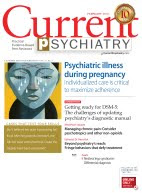Philip G. Janicak, MD, Professor, Department of Psychiatry, Rush University Medical Center, Chicago, IL
Sheila M. Dowd, PhD, Assistant Professor, Department of Psychiatry, Department of Behavioral Sciences, Rush University Medical Center, Chicago, IL
Jeffrey T. Rado, MD, Assistant Professor, Department of Psychiatry and Medicine, Rush University Medical Center, Chicago, IL
Mary Jane Welch, DNP, APRN, BC, CIP, Assistant Professor, College of Nursing, Director, Human Subjects Protection, Rush University Medical Center, Chicago, IL
The brain is an electrochemical organ, and its activity can be modulated for therapeutic purposes by electrical, pharmacologic, or combined approaches. In general, neuromodulation induces electrical current in peripheral or central nervous tissue, which is accomplished by various techniques, including:
- electroconvulsive therapy (ECT)
- vagus nerve stimulation (VNS)
- transcranial magnetic stimulation (TMS)
- deep brain stimulation (DBS).
Neuromodulation techniques are categorized based on their risk level as invasive or noninvasive and seizurogenic or nonseizurogenic. Although these and other approaches are being considered for various neuropsychiatric disorders, the most common application is for severe, treatment-resistant depression. Therefore, this article focuses on FDA-approved neuromodulation treatments for depression, with limited discussion of other indications.
Read full text (free access)
Comment on this article
Email the editor


No comments:
Post a Comment